Looking to really beef up your shoulder workouts? You’ve come to the right place. We’ve rounded up the best shoulder exercises you can add to your routine in 2024, each one designed to pack on muscle and help take your strength to new heights.
If you’ve been in the gym but don’t really know how to get those strong and broad shoulders you see on the biggest people in the gym, this guide and these exercises will teach you everything you need to know.
Let’s roll through the absolute best shoulder exercises that’ll not only enhance your physique but also boost your performance in many lifts in the gym. Ready to transform those shoulders into boulders? Let’s get started.
Importance of Strong Shoulders
Why do shoulders matter so much? Well, if you’re lifting weights or just trying to keep fit, these muscles are your go-to for supporting almost anything you do with your upper body. Climbing a tree, lifting a big box, or just showing off with an overhead press—shoulders are where it all starts.
Strong shoulders boost your stamina and power in pretty much all physical activities. Oh, and a nice pair of well-toned shoulders looks pretty great too, helping you look broad and building that v-taper that you see on guys like Chris Bumstead.
On top of all that, keeping your shoulders strong means you’re way less likely to get injured. Stronger muscles keep things glued together, avoiding those nasty dislocations or sprains that make you sit out of the gym and all athletic activity for weeks. Wanna know more on dodging the pain ? Hit up our guide on avoiding shoulder injuries.
Also, nobody wants to look lopsided by focusing on just one muscle group in the upper body, so shoulder workouts will help keep that balance. Now, let’s get into the actual anatomy of your shoulder muscles.
Shoulder Muscles Anatomy Overview
Deltoid Muscle Anatomy | AnatomyZone
It’s important to get comfortable with the basics of shoulder strength training before hitting the weights like a mad-man. Master the details of these muscles, and training properly will be soo much easier.
Getting to know the anatomy of your shoulder muscles is the foundation of effective training. Understanding the muscles you’re working with isn’t just about impressing your gym buddies; it’s crucial for maximizing each exercise and preventing injuries. Here’s a brief rundown:
Primary Muscles of the Shoulder:
- Deltoids: This cap-like muscle envelops the shoulder joint and is divided into three segments: anterior (front), lateral (middle), and posterior (rear). Each part plays a distinct role in various arm movements, from pressing to lifting.
- Rotator Cuff: A group of four muscles (supraspinatus, infraspinatus, teres minor, and subscapularis) that surround the shoulder joint, stabilizing it and allowing for a wide range of complex movements.
- Trapezius: This large muscle extends from your neck to the mid-back and shoulders, involved in shrugging, neck extension, and scapular movement.
A solid understanding of these components will help you better align your workouts to target the right areas, ensuring your shoulders not only look good but are also strong and stable.
For more in-depth guidance on each muscle’s role and how to engage them properly, consider exploring detailed anatomy charts or professional training videos.
The 14 Best Shoulder Exercises to Add to Your Routine
1. Seated Dumbbell Shoulder Press

Agreed upon by all bodybuilders and competitive lifters as one of the best shoulder exercises, if not THE best shoulder exercise: the Seated Dumbbell Shoulder Press. A cornerstone in shoulder training, the seated dumbbell shoulder press allows for excellent range of motion while providing stability from a seated position, making it ideal for focusing intensely on the deltoids.
This is the best overall shoulder exercise. I’d recommend starting almost every shoulder day with this exercise, or one of the other pressing variations we’ll go over later.
Proper Form and Technique
- Starting Position: Sit on a bench with back support, holding dumbbells at shoulder height with palms facing forward.
- Press Up: Exhale as you press the dumbbells upward until your arms are fully extended above your head.
- Controlled Descent: Slowly lower the dumbbells back to the starting position while inhaling.
Benefits
- Isolation: Minimizes lower body assistance, focusing the effort on the shoulders.
- Range of Motion: Allows for a full range of motion in the shoulder joint.
- Stability and Control: The seated position helps maintain form and reduce the risk of injury.
2. Dumbbell Lateral Raise
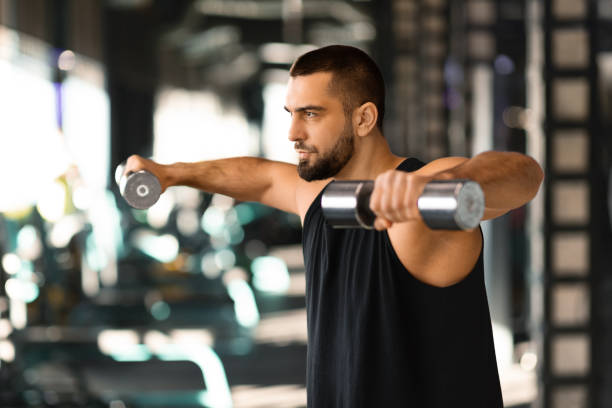
Lateral raises are widely considered the best shoulder exercises for the side delts, aka the medial deltoids. The Dumbbell lateral raises are crucial for achieving that sought-after broad-shouldered look.
Make sure you are doing these with light weight, and you are controlling the eccentric (lowering) part of the movement. If you started the workout with presses, these are a great 2nd exercise to do.
Proper Form and Technique
- Starting Position: Stand with feet hip-width apart, dumbbells at your sides, palms facing in.
- The Lift: With a slight bend in your elbows, raise the dumbbells out to your sides until your arms are parallel with the floor.
- Controlled Lowering: Gradually lower the weights back to the starting position.
Benefits
- Medial Deltoid Isolation: Primarily targets the shoulder’s middle heads.
- Aesthetic Enhancement: Helps develop the shoulder’s cap, contributing to a more defined shoulder silhouette.
- Accessibility: Can be performed with various weights and suitable for all fitness levels.
3. Barbell Overhead Press (Military Press)
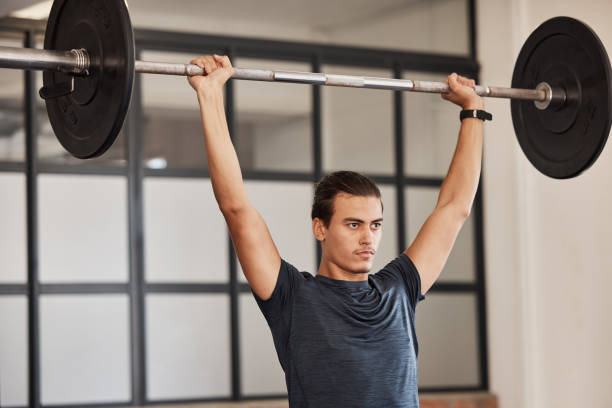
The barbell overhead press is a powerful compound exercise that builds upper body strength and mass, known for its effectiveness in enhancing shoulder, tricep, and core stability.
One thing I’d say about the military press is that you should really be careful when doing these. Form is everything, especially since you don’t have the seated support for your back. Consider wearing a belt, and make sure you aren’t trying to lift too heavy of a weight! Keep that back straight and core tight.
Proper Form and Technique
- Starting Position: Stand with feet shoulder-width apart, grip the barbell at shoulder level with palms facing forward.
- Execution: Press the barbell overhead until your arms are fully extended, keeping your core tight.
- Return: Lower the barbell back to the starting position in a controlled manner.
Benefits
- Comprehensive Strength Building: Engages the entire deltoid area, triceps, and upper chest.
- Core Involvement: Improves core strength and stability as it stabilizes the lift.
- Functional Fitness: Enhances performance in everyday activities and other lifts.
4. Dumbbell Front Raises
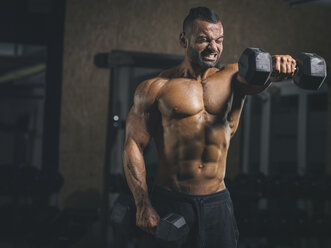
Dumbbell front raises are the best exercise for targeting the front deltoid. On a basic level, it makes sense if you think about it. The lateral raise (consists of lifting weight out to your side) is the best for your side delt, and the front raise (consists of lifting weight in front of you) is the best for your front delt!
This is another exercise that should be done with light weights, maintaining proper form and eccentric control. If you hit presses, then lateral raises, this would be a great third exercise choice. The front raises will enhance the size of the front part of your shoulder, enhancing the front shoulder’s strength and appearance.
Proper Form and Technique
- Starting Position: Stand with feet shoulder-width apart, dumbbells in front of your thighs, palms facing your thighs.
- The Lift: Raise the dumbbells straight in front of you to shoulder height, keeping your arms straight.
- The Descent: Lower the dumbbells back down to the starting position smoothly.
Benefits
- Anterior Deltoid Focus: Directly targets the front part of the shoulders.
- Postural Improvement: Strengthens muscles that are crucial for good posture.
- Versatility: Can be performed standing or seated, with dumbbells or a barbell.
5. Cable Lateral Raises

Cable lateral raises are another form of lateral raises that can be done on top of, or substituted for the dumbbell lateral raises.
The great part about the cable lateral raise is that they provide constant tension during the lift, offering a unique challenge that can lead to superior deltoid development.
With cables, you can also really lock in the form, and minimize the swaying of the rest of your body. On top of that, you can do partial reps and forced reps a lot easier.
Proper Form and Technique
- Starting Position: Stand next to a cable machine with the pulley set at the lowest position. Hold the handle with the hand farthest from the machine.
- The Lift: Keeping your body fixed and arm slightly bent, raise your arm to the side until it is about shoulder height.
- The Descent: Slowly lower back to the starting position, maintaining tension on the cable.
Benefits
- Constant Tension: The cable machine keeps muscles under continuous strain, enhancing growth.
- Unilateral Training: Helps correct imbalances between the left and right shoulders.
- Precision: Allows for precise adjustments in resistance and angle to target specific areas of the deltoid.
6. Shoulder Press Machine
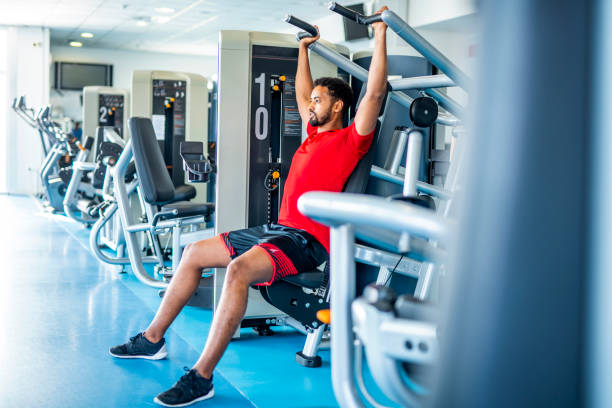
The shoulder press machine offers a guided motion that is ideal for beginners or those looking to place less strain on their joints while still targeting the deltoids effectively.
If you feel uncomfortable doing dumbbell or barbell presses, especially if you feel it’s putting pressure on your back, these are for you. Machine shoulder presses ensure you are using the right form, and also make training to failure a lot easier and more safe. This is a great exercise to start if you are just getting into shoulder workouts.
Proper Form and Technique
- Setup: Adjust the seat so that the handles align with your shoulders. Grip the handles.
- Execution: Push the handles overhead until your arms are extended.
- Return: Slowly lower the handles back to the starting position.
Benefits
- Ease of Use: Great for beginners due to its fixed path of motion.
- Joint Safety: Reduces the strain on the shoulder joints by providing support throughout the movement.
- Consistent Load: Provides a steady load throughout the exercise, which can be ideal for rehabilitation or for those focusing on form.
7. Dumbbell Shrugs

Dumbbell shrugs are a straightforward and effective exercise for building the trapezius muscles, which are crucial for overall shoulder and neck strength.
This is my favorite exercise for building the traps, which will add the size on the top of your shoulders and around the neck. Make sure to really squeeze when doing these, and if you bring your shoulders slightly back as you lift them, that is ideal.
Proper Form and Technique
- Starting Position: Stand with feet shoulder-width apart, dumbbells at your sides.
- Execution: Lift your shoulders towards your ears in a shrug, hold briefly at the top.
- Return: Lower your shoulders back down smoothly.
Benefits
- Trapezius Development: Primarily targets the upper traps.
- Posture Improvement: Enhances neck and upper back posture.
- Versatility: Can be done with dumbbells, barbells, or kettlebells.
8. Bent-Over Reverse Dumbbell Flyes
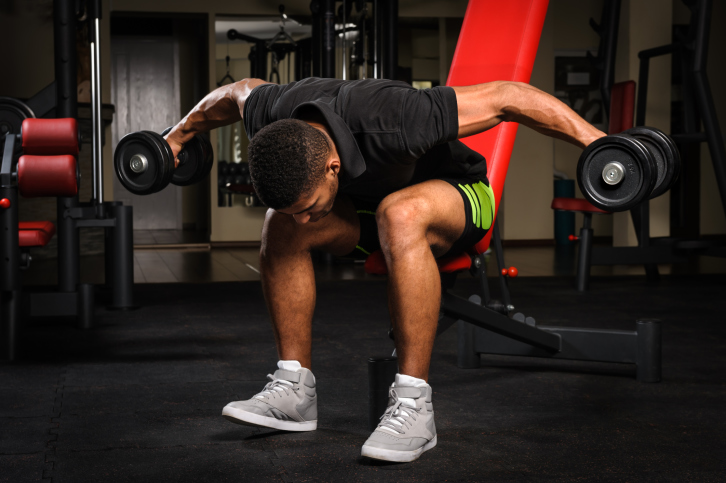
Focusing on the posterior deltoids, bent-over reverse dumbbell flyes are essential for balanced shoulder development and posture improvement.
These will really build your rear delts in the back of your shoulder. Do these with really light weight and focus on squeezing those rear delts together like you’re trying to pinch the muscles.
Proper Form and Technique
- Starting Position: Bend at the waist with knees slightly bent, holding dumbbells with palms facing each other.
- The Lift: With elbows slightly bent, lift the dumbbells out to the side until your arms are parallel to the floor.
- The Lower: Gradually lower the dumbbells back to the starting position.
Benefits
- Rear Deltoid Enhancement: Targets the often neglected rear deltoids.
- Upper Back Strengthening: Also engages muscles across the upper back.
- Postural Benefits: Helps counteract the forward slump from sitting and other daily activities.
9. Cable Face Pulls

Cable face pulls are a versatile exercise targeting the rear deltoids, traps, and rhomboids, promoting better shoulder health and function.
These are a great option for anyone who doesn’t want to do shrugs, and they also will do amazing things for the rear delts as well. Once again, keep the weight light and feel the squeeze.
Proper Form and Technique
- Setup: Attach a rope to a high pulley. Grip each end with palms facing each other.
- Pull: Draw the rope towards your forehead while flaring your elbows out and squeezing your shoulder blades together.
- Return: Slowly extend arms back to the starting position.
Benefits
- Rear Delts and Upper Back Focus: Effectively targets the rear aspects of the deltoids and upper back.
- Shoulder Health: Excellent for improving shoulder stability and balancing muscular development.
- Postural Correction: Aids in correcting rounded shoulders.
10. Smith Machine Shoulder Press
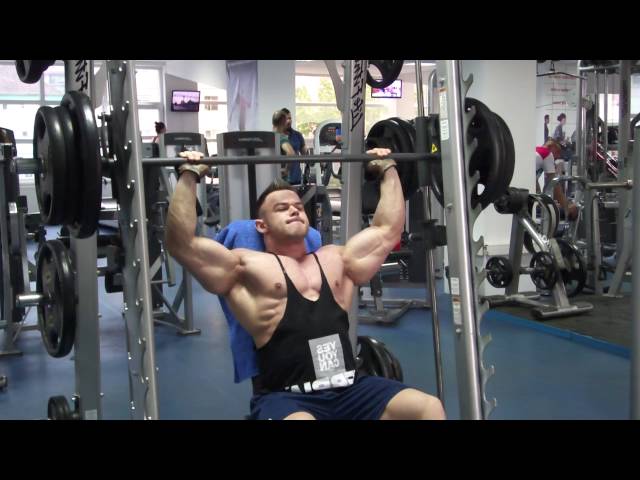
The Smith machine shoulder press is a safer alternative to the free-weight shoulder press, offering stability and support which is especially beneficial for those with balance issues or injuries.
I LOVE this exercise because I can safely train to failure without risking injury or just total disaster. It is also a lot easier to control the eccentric part of the movement with the smith machine, which is huge for muscle hypertrophy.
Proper Form and Technique
- Starting Position: Sit or stand beneath the Smith machine bar set at about shoulder height.
- Execution: Grip the bar and press upwards until your arms are extended.
- Return: Lower the bar under control to about chin level.
Benefits
- Stability: The fixed path of motion helps maintain form, reducing the risk of injury.
- Isolation: Allows for focused work on the deltoids without the need to stabilize with other muscles.
- Adaptability: Can be adjusted for different heights and sizes to accommodate all users.
11. Dumbbell Arnold Press
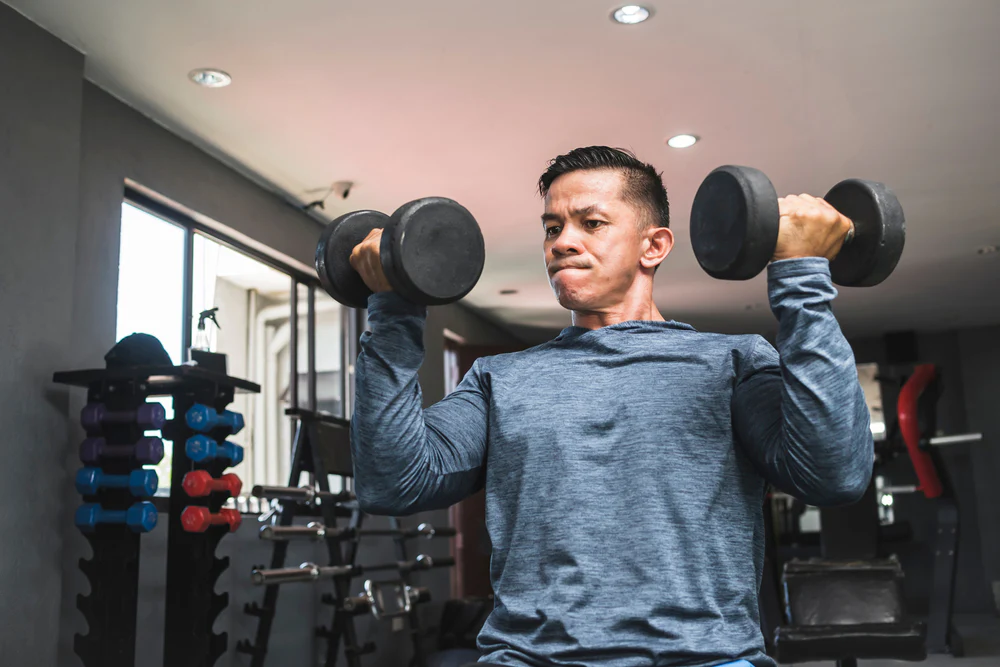
Named after Arnold Schwarzenegger, the Arnold press adds a twist to the traditional shoulder press, enhancing the range of motion and targeting multiple angles of the shoulder muscles.
These will really burn the whole shoulder, in a good way. They also will help you work on the rotator cuffs and building your range of motion.
Proper Form and Technique
- Starting Position: Sit with dumbbells held in front of you, palms facing your shoulders.
- Press and Rotate: As you press the dumbbells overhead, rotate your arms so that your palms face forward at the top.
- Return: Rotate your palms back towards you as you lower the dumbbells to the starting position.
Benefits
- Dynamic Range of Motion: Increases the range of motion in the shoulder joint.
- Comprehensive Deltoid Activation: Targets all three deltoid heads for balanced development.
- Core Involvement: Engages the core throughout the rotation for added stability.
12. Reverse Pec Fly Machine
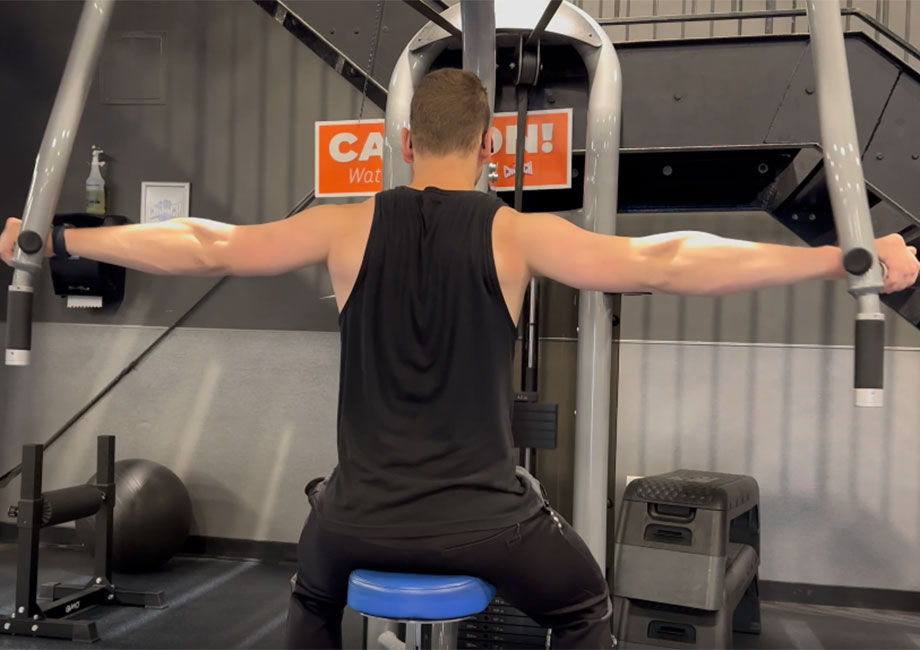
The reverse pec fly machine specifically targets the rear deltoids and upper back, providing a controlled motion that ensures effective isolation and safety.
These are a great alternative to the dumbbell rear delt fly, as they help you maintain proper form. You know the deal, just squeeze those muscles together and control the movement.
Proper Form and Technique
- Setup: Adjust the machine to fit your height and sit facing the machine with your chest against the pad.
- Execution: Grip the handles and pull them back until your shoulder blades are squeezed together.
- Return: Slowly return to the starting position without letting the weights rest in the stack.
Benefits
- Focused Rear Deltoid Work: Isolates the rear deltoids effectively.
- Safety and Control: The machine provides a stable environment to perform the exercise without risk of injury.
- Upper Back Strengthening: Complements the deltoid work by engaging the upper back muscles.
13. Plate Front Raise

Plate front raises are a simple yet effective exercise for strengthening the front deltoids, with the weight plate offering a unique resistance curve that challenges the muscles differently than dumbbells.
Proper Form and Technique
- Starting Position: Stand with your feet hip-width apart, holding a weight plate with both hands at waist level.
- The Lift: Raise the plate straight up in front of you to shoulder height.
- Controlled Lower: Slowly lower the plate back to the starting position.
Benefits
- Front Deltoid Isolation: Primarily targets the front part of the shoulders.
- Core Engagement: Requires core stabilization to maintain posture during the lift.
- Versatility: Can be performed with different sized plates to adjust difficulty.
14. Cable Pull Apart

Possibly my favorite exercise for the rear deltoids, the cable pull aparts are an excellent exercise for not just targeting those rear delts, but also for improving shoulder stability and posture.
The cables help you feel the constant tension of the exercise, and make it a lot easier to squeeze the muscles without feeling a weird shoulder pain.
Proper Form and Technique
- Setup: Attach a rope to a cable machine set at about chest height.
- Execution: Grip the rope with both hands and pull it apart horizontally until your hands are wide apart, squeezing the shoulder blades together.
- Return: Slowly bring your hands back together, maintaining tension throughout the motion.
Benefits
- Rear Deltoid Focus: Effectively targets the often overlooked rear deltoids.
- Postural Improvement: Helps strengthen the muscles that support proper shoulder alignment.
- Constant Tension: The cable machine ensures that the muscles are under continuous strain, enhancing muscle development.
These exercises provide a comprehensive approach to shoulder training, making sure that all parts of the deltoids are effectively worked through a variety of movements and equipment.
Example Workout Using the Best Shoulder Exercises
- Dumbbell Shoulder Press – 1-2 warm-up sets, 3 working sets of 8-12 reps
- Dumbbell Lateral Raise – 3 sets of 10-12 reps
- Dumbbell Front Raise – 3 sets of 10-12 reps
- Reverse Dumbbell Fly – 3 sets of 12-15 reps
- Dumbbell Shrugs – 3 sets of 12-15 reps
This workout effectively targets all parts of your shoulder muscle, making it a very high volume and intense workout, but one that’ll lead to growth and strength.
Tips and Tricks for Effective Shoulder Training
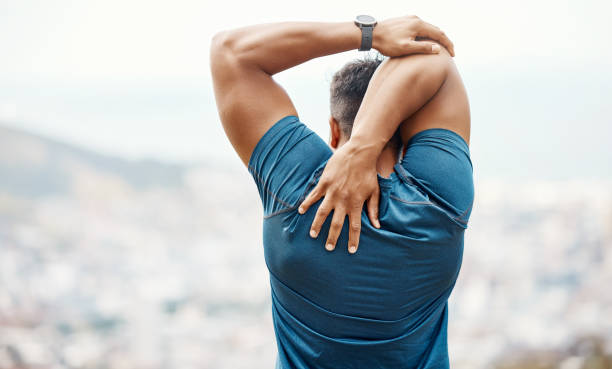
To optimize your shoulder workouts and ensure you’re on the path to building strong, resilient shoulders, keep these key tips and tricks in mind:
1. Prioritize Form Over Weight: It’s crucial to master the correct form before attempting to increase the weights. Proper technique ensures that you target the intended muscles effectively and reduce the risk of injury.
2. Include a Variety of Movements: Shoulders are complex joints that benefit from a multidirectional approach. Incorporate exercises that target each part of the deltoid muscle (anterior, medial, and posterior) as well as the supporting muscles like the trapezius and rotator cuff to ensure balanced development.
3. Warm-Up Thoroughly: Given the shoulder’s wide range of motion and susceptibility to injuries, a thorough warm-up is essential. Start with dynamic stretches and light, movement-specific exercises to increase blood flow and prepare the muscles and joints for the workload ahead.
4. Use Controlled Movements: Especially with exercises like lateral raises or front raises, avoid using momentum to lift the weights. Focus on slow, controlled movements to maximize muscle tension and effectiveness. I promise you, if you slow down the lowering phase of the lifts as well, your muscles will grow soo much faster.
5. Employ Progressive Overload: Gradually increase the intensity of your workouts by adding more weight, increasing the number of reps, or reducing rest periods. This progressive challenge is necessary to foster muscle growth and strength gains.
6. Don’t Neglect Recovery: Shoulders can be particularly prone to overuse injuries, so incorporating adequate rest and recovery is as important as the workouts themselves. Include rest days in your routine, and consider using ice or heat therapy and massage if you’re experiencing soreness or tightness.
Conclusion
There you have it—the best shoulder exercises to revolutionize your training routine in 2024. Armed with these top-tier movements, you’re well on your way to building the strong, broad shoulders you’ve been aiming for.
Keep these 14 best shoulder exercises in your regular rotation, stay consistent, and you’ll witness substantial improvements in both strength and aesthetics.
Remember, the best results come from dedication and hard work—so keep pressing forward, and let the best shoulder exercises transform your fitness journey.







